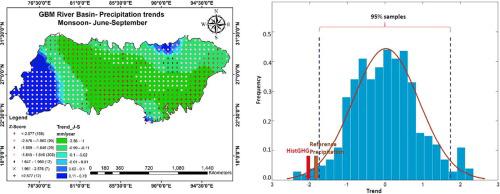Geoscience Frontiers ( IF 8.5 ) Pub Date : 2021-04-03 , DOI: 10.1016/j.gsf.2021.101186 Chetan Sharma , Anoop Kumar Shukla , Yongqiang Zhang

|
Ganga-Brahmaputra-Meghna (GBM) river basin is the third-largest and one of the most populated river basins in the world. As climate change is affecting most of the hydrometeorological variables across the globe, this study investigated the existence of climate change signal in all four climatological seasons in the GBM river basin and assessed the contribution of anthropogenic activities, i.e., Greenhouse Gases (GHGs) emission in the change. Significant decreasing trends in the monsoon and a small increase in pre-monsoon precipitation were observed. Negligible change was detected in post-monsoon and winter season precipitation. CMIP5 GCMs were used for climate change detection, change point estimation, and attribution studies. Support Vector Machine (SVM) regression method was adopted to downscale GCM variables at the local scale. Monte-Carlo simulation approach was used to detect changes in different seasons. The climate change ‘signals’ were detectable after the year 1980 using Signal to Noise ratio (SNR) method in the majority of central and north-western regions. The change point was detectable only in annual monsoon precipitation at the basin level. Attribution analysis indicated >50% contribution of anthropogenic activities (GHGs) to annual monsoon precipitation changes. So, there is high confidence that monsoon precipitation in GBM has significantly changed due to anthropogenic activities. Different mitigation and adaption measures are also suggested, which may be adopted to manage the growing demand and water availability in the basin.
中文翻译:

恒河-布拉马普特拉-梅格纳河流域的气候变化检测与归因
恒河-布拉马普特拉-梅格纳河(GBM)流域是世界第三大流域,也是人口最多的流域之一。由于气候变化正在影响全球大多数水文气象变量,因此本研究调查了GBM流域所有四个气候季节中气候变化信号的存在,并评估了人为活动(即温室气体(GHGs)排放)的贡献。改变。观察到季风明显下降趋势,季风前降水略有增加。在季风后和冬季降水中检测到微不足道的变化。CMIP5 GCM用于气候变化检测,变化点估计和归因研究。采用支持向量机(SVM)回归方法在本地范围内缩小GCM变量。蒙特卡洛模拟方法用于检测不同季节的变化。1980年以后,在大多数中部和西北部地区,使用信噪比(SNR)方法可以检测到气候变化的“信号”。仅在流域水平的季风降水中才能检测到该变化点。归因分析表明,人为活动(GHG)对季风降水变化的贡献超过50%。因此,人们非常有信心,由于人为活动,GBM中的季风降水已经发生了显着变化。还建议采取不同的缓解和适应措施,以应对流域不断增长的需求和水的可利用性。1980年以后,在大多数中部和西北部地区,使用信噪比(SNR)方法可以检测到气候变化的“信号”。仅在流域水平的季风降水中才能检测到该变化点。归因分析表明,人为活动(GHG)对季风降水变化的贡献超过50%。因此,人们非常有信心,由于人为活动,GBM中的季风降水已经发生了显着变化。还建议采取不同的缓解和适应措施,以应对流域不断增长的需求和水的可利用性。1980年以后,在大多数中部和西北部地区,使用信噪比(SNR)方法可以检测到气候变化的“信号”。仅在流域水平的季风降水中才能检测到该变化点。归因分析表明,人为活动(GHG)对季风降水变化的贡献超过50%。因此,人们非常有信心,由于人为活动,GBM中的季风降水已经发生了显着变化。还建议采取不同的缓解和适应措施,以应对流域不断增长的需求和水的可利用性。归因分析表明,人为活动(GHG)对季风降水变化的贡献超过50%。因此,人们非常有信心,由于人为活动,GBM中的季风降水已经发生了显着变化。还建议采取不同的缓解和适应措施,以应对流域不断增长的需求和水的可利用性。归因分析表明,人为活动(GHG)对季风降水变化的贡献超过50%。因此,人们非常有信心,由于人为活动,GBM中的季风降水已经发生了显着变化。还建议采取不同的缓解和适应措施,以应对流域不断增长的需求和水的可利用性。











































 京公网安备 11010802027423号
京公网安备 11010802027423号